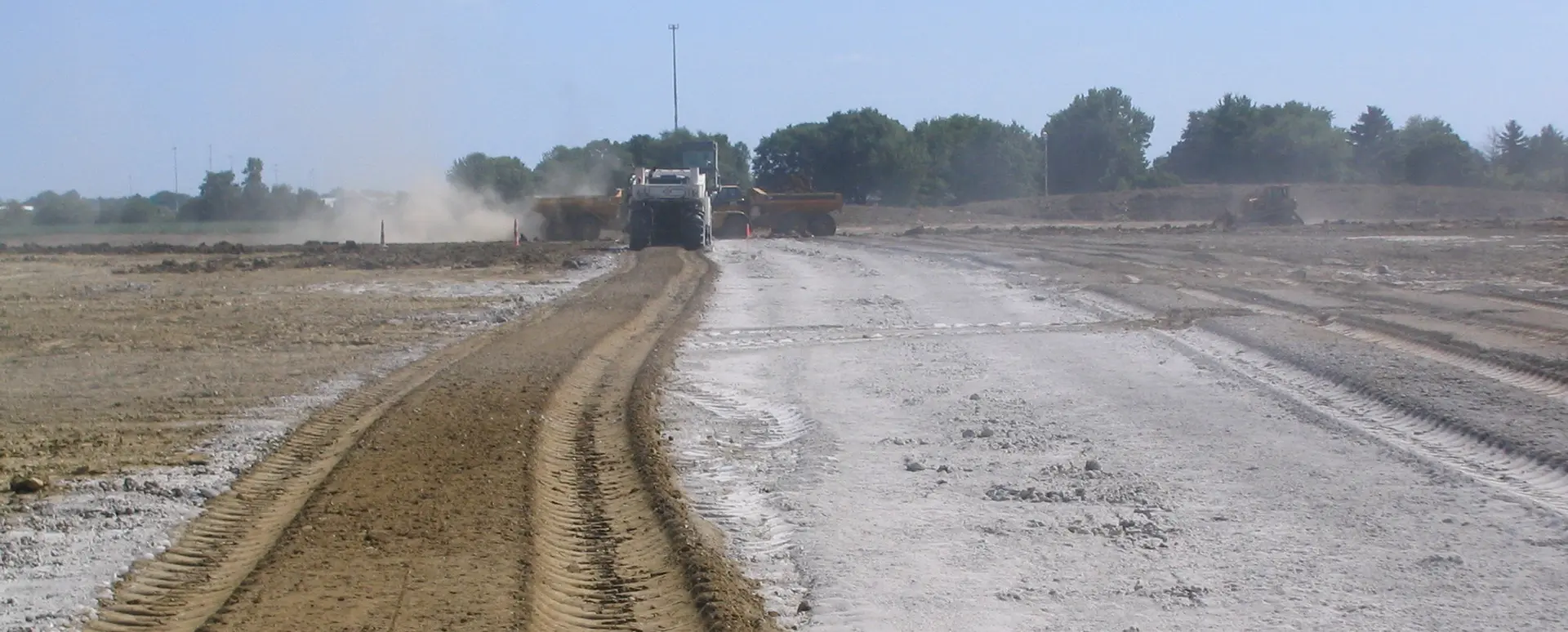Understanding Soil Stabilization with Cement and Lime

Creating a strong and stable foundation is essential when constructing buildings, roads, and other infrastructure. However, not all soils are naturally suitable for construction. Some may be too wet, soft, or prone to deformation and settling, which can lead to structural issues down the line; this is where soil stabilization comes in.
Soil stabilization is the process of enhancing the physical properties of soil to make it more suitable for construction. There are various soil stabilization methods, but two of the most common and effective techniques involve cement and lime. In this article, we’ll explore soil stabilization with cement and lime in more depth.
Let’s work together.
Importance of Soil Stabilization in Construction
Soil stabilization is a critical step in many construction projects. Here’s why:
- Improves soil strength and bearing capacity
- Reduces shrink-swell potential of expansive soils
- Provides a stable base for foundations, roadways, and other structures
- Minimizes soil erosion and dust generation
- Is more cost-effective than removing and replacing poor soils
- Is a green construction practice, eliminating the need for virgin material in remove and replace operations
Without proper soil stabilization, structures built on poor soils are much more likely to experience issues like settlement, cracking, and even failure. Stabilizing soils upfront can save significant time, money, and headaches in the long run.
Processes Involved in Soil Stabilization
Soil stabilization generally involves several key steps:
- Soil testing and analysis to determine soil properties and stabilization needs
- Site preparation, including clearing, grubbing, and grading
- Applying and mixing the stabilizing agent (e.g., cement or lime) into the soil
- Compacting the treated soil to achieve the desired density and strength
- Curing the stabilized soil before placing additional layers or structures
The specific processes and equipment used will vary depending on the soil conditions, project requirements, site-specific challenges, and stabilization method being used.
Different Methods of Soil Stabilization
There are several different methods that can be used to stabilize soils, including:
- Mechanical stabilization (compaction, geotextiles, etc.)
- Chemical stabilization (cement, lime, fly ash, etc.)
- Biological stabilization (vegetive, microbial-induced calcite precipitation)
Each method has its advantages and limitations, and the best approach will depend on the specific soil conditions and project requirements.
Chemical Stabilization
Chemical stabilization is one of the most widely used soil stabilization methods. It involves adding a chemical agent to the soil to improve its engineering properties. The most common chemical stabilizers are cement, lime, fly ash, and related byproducts. These agents work by altering the soil chemistry and binding the soil particles together to create a stronger, more stable matrix. Which option you use depends predominantly on the properties of the existing soil.
Lime and Cement as Soil Stabilizers
Among the various chemical stabilizers, lime and cement are two of the most popular and effective options. Let’s take a closer look at how each one works.
Role of Lime in Soil Stabilization
Lime, in the form of quicklime (calcium oxide), hydrated lime (calcium hydroxide), or lime kiln dust (LKD), can be used to stabilize clay bearing soils. When mixed into the soil, lime undergoes several reactions:
- Drying: Lime is the most effective drying solution. Quicklime and LKD chemically combine with water in the soil, effectively lowering the moisture content. This reaction releases heat, helping to further dry the soil. This reaction happens essentially immediately.
- Modification: Calcium ions from lime displace ions, such as aluminum and silica, in the clay structure, reducing plasticity and shrink-swell potential. This reaction can happen in as little as two hours.
- Stabilization: Lime reacts with clay minerals and other silica/alumina sources to form calcium silicate hydrates (CSH) and calcium aluminate hydrates (CAH). These pozzolanic reactions cement the soil particles together.
These reactions result in a stronger, drier, and more workable soil that is better able to support structures and facilitate construction.
Pros and Cons of using Lime
Advantages of lime stabilization include:
- Effective for Clay Soils: Effectively treats plastic clay soils
- Rapid Drying: Dries wet soils quickly
- Reduces Shrink-Swell: Significantly reduces shrink-swell potential
- Fast Working Platform: Produces a working platform within 1-4 hours after mixing
- Economical: Typically, more economical and better for the environment than removing and replacing the soil
- Autogenous Healing: Lime stabilized soils have the ability to “self-heal”
- Freeze-Thaw Resistance: Improves soil resistance to freezing and thawing
- Flexible Construction: Many lime specifications require compaction within 24-hours, compared to 3 to 4 hours with cement. If delivery is delayed or equipment breaks down, lime allows time for correction.
When using lime stabilization, there are a few important considerations:
- Gradual Strength Gain: Strength gain occurs more gradually than cement
- Soil Type Considerations: Most effective for soils that contain at least 20% clay
- Mellowing Period: Requires a short mellowing period (2-24 hours) to allow initial hydration and soil modification reactions before compaction
- Safety Precautions: As with any chemical, proper safety precautions and PPE should be used when handling lime
Lime is one of the most effective and economical solutions for stabilizing problematic soils. With proper design and application, lime can significantly improve soil properties and create a stable foundation for construction.
Role of Cement in Soil Stabilization
Cement can be used to stabilize sandy and silty soils. When mixed with soil and water, cement undergoes a hydration reaction, forming calcium silicate hydrate (CSH) gel which binds granular soil particles together. This cemented soil matrix has increased strength, reduced permeability, and improved resistance to erosion.
Pros and Cons of Using Cement
Benefits of cement stabilization include:
- Versatile: Effective for a broad range of granular soils
- High Strength: Provides high strength and durability
- Rapid Strength Gain: Faster strength gain compared to lime
- Freeze-Thaw Resistance: Improves soil resistance to freezing and thawing
Some considerations when using cement include:
- Mixing in Wet Soils: Can be difficult to achieve even distribution in wet/plastic clays
- Dust Irritation: Cement is a very fine powder and is an irritant; proper safety gear is necessary, and care must be taken when spreading even with moderate wind.
Despite these considerations, cement remains a highly effective and versatile solution for stabilizing soils. Its ability to provide rapid strength makes it a solid choice for many construction projects.
Comparing Lime and Cement as Soil Stabilizing Agents
When comparing lime soil stabilization and cement stabilization, both are effective soil stabilizers, but they have some key differences that make them suitable for different applications.
Cement offers beneficial effects when stabilizing granular soils, while lime is most effective for plastic soils. Cement also often provides faster strength gain compared to lime. However, wet/plastic clays often prefer lime due to its drying action and workability improvements.
The choice between lime and cement will depend on the specific soil conditions, desired properties, and cost considerations. In some cases, a combination of lime and cement may provide the best results.
Soil stabilization with cement or lime is a proven technique for improving soil engineering properties, providing a solid working platform, and creating stable foundations for construction. By understanding the mechanisms, benefits, and limitations of each stabilizer, construction professionals can select the best approach for their specific project needs.
With proper design and application, soil stabilization can save time and costs compared to traditional methods of removing and replacing poor soil. The result is a stronger, more resilient foundation that will facilitate construction and support structures for years to come.
About Mintek Resources
At Mintek Resources, we specialize in providing cement, lime, and other soil stabilization, modification and drying solutions for construction projects across the United States. With over 20 DOT approvals and a strong network serving over 29 states, we have the technical expertise and experience to help select the optimal products for any soil type and project requirements.
Our soil stabilization products include:
- Quicklime and hydrated lime – highly effective for drying wet soils
- Calciment® LKD (lime kiln dust) – an economical clay soil stabilizer
- Cement – provides high-strength stabilization for a range of soils
We offer flexible packaging and delivery options to meet the needs of any job site of any size. Our team is committed to providing the highest level of customer service and technical support to ensure the success of your soil stabilization projects.
Contact Mintek Resources today to explore our soil stabilization solutions.
We're here to help you find the best solution for your next project. Let's get started. Give me a call at 937-641-9901.

Josh Weser
Mintek Resources
Related Posts
Tariffs Disrupt Construction: Lime Keeps Projects Moving
Tariffs are reshaping the construction landscape. From cement and steel to aluminum and other essential materials, shifting trade policies are creating ripple effects across the industry. Even when prices hold steady, the uncertainty around future costs and sourcing...
Unlocking Pavement Potential: The Long-Term Value of Chemically Stabilized Subgrades
A Foundation in Crisis America’s roadways are the backbone of its economy and daily life, yet they continue to show signs of chronic underinvestment. According to the American Society of Civil Engineers’ 2025 Infrastructure Report Card, the nation’s infrastructure...
Ground Control: Comparing Lime and Geosynthetics for Long-Lasting Stability
When building infrastructure on weak in-situ soils, a well-designed foundation is essential to ensure long-term resilience. Whether you're constructing roads, embankments, or industrial platforms, ensuring subgrade stability is critical—not just for performance, but...